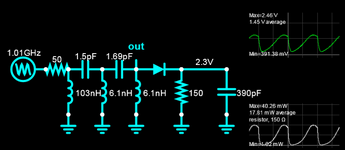Tinoonga
Newbie
Hi
I am trying to simulate a chart with conversion efficiency of a rectenna but so far the info i have been reading online is for circuits which don't match with what I am working with.
What formula for conversion efficiency can i use on the following schematic. Please help

I am trying to simulate a chart with conversion efficiency of a rectenna but so far the info i have been reading online is for circuits which don't match with what I am working with.
What formula for conversion efficiency can i use on the following schematic. Please help



